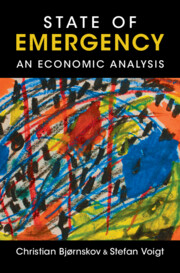Book contents
- State of Emergency
- State of Emergency
- Copyright page
- Contents
- Figures
- Tables
- Acknowledgments
- 1 Introduction
- 2 The Architecture of Emergency Constitutions
- 3 The Determinants of Emergency Constitutions
- 4 Why Do Governments Call a State of Emergency?
- 5 The Effectiveness of Emergency Constitutions after Natural Disasters
- 6 When Does Terror Induce a State of Emergency? And What Are the Effects?
- 7 States of Emergency after Domestic Turmoil
- 8 Dealing with Disaster
- 9 Keeping up the Balance between the Federation and the States
- 10 Constitutionalized Media Freedom during Emergencies
- 11 Unconstitutional States of Emergency
- 12 The COVID-19 Pandemic, States of Emergency, and Reliance on Executive Decrees
- 13 Returning to the Status Quo Ante?
- 14 Contracting for Catastrophe
- 15 The Future of States of Emergency
- References
- Index
6 - When Does Terror Induce a State of Emergency? And What Are the Effects?
Published online by Cambridge University Press: 01 November 2024
- State of Emergency
- State of Emergency
- Copyright page
- Contents
- Figures
- Tables
- Acknowledgments
- 1 Introduction
- 2 The Architecture of Emergency Constitutions
- 3 The Determinants of Emergency Constitutions
- 4 Why Do Governments Call a State of Emergency?
- 5 The Effectiveness of Emergency Constitutions after Natural Disasters
- 6 When Does Terror Induce a State of Emergency? And What Are the Effects?
- 7 States of Emergency after Domestic Turmoil
- 8 Dealing with Disaster
- 9 Keeping up the Balance between the Federation and the States
- 10 Constitutionalized Media Freedom during Emergencies
- 11 Unconstitutional States of Emergency
- 12 The COVID-19 Pandemic, States of Emergency, and Reliance on Executive Decrees
- 13 Returning to the Status Quo Ante?
- 14 Contracting for Catastrophe
- 15 The Future of States of Emergency
- References
- Index
Summary
The relationship between terrorist activities and states of emergency has never been explored in a cross-country perspective. This chapter is a first step to change that. Given that a terror act has been committed, what are the factors that lead governments to declare a state of emergency – or refrain from declaring it? And given that a state of emergency has been declared, what are the effects thereof? In this chapter, two world regions are analyzed: seventy-nine countries having Western-style constitutions and the member states of the Organization of Islamic Countries. We find that more terrorist incidents increase the likelihood of a state of emergency. Interestingly, emergencies are less likely to be declared in election years, supposedly because governments believe them to be unpopular. Once a state of emergency is declared, it generally leads to substantially more government repression. Finally, countries already under a state of emergency are more likely to suffer from additional terror attacks, challenging the effectiveness of states of emergency.
Keywords
- Type
- Chapter
- Information
- State of EmergencyAn Economic Analysis, pp. 131 - 189Publisher: Cambridge University PressPrint publication year: 2024

